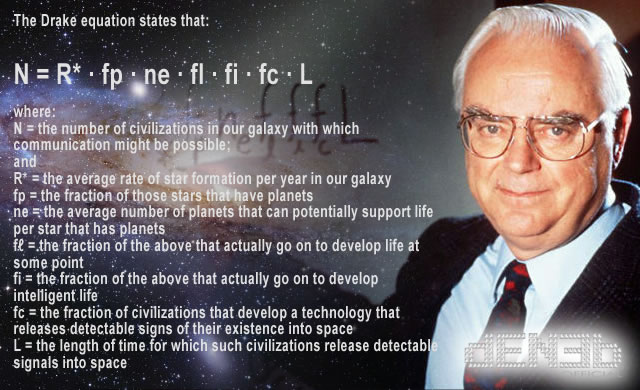
L’equazione di Drake (nota anche come equazione o formula di Green Bank) è una formula matematica utilizzata per stimare il numero di civiltà extraterrestri in grado di comunicare esistenti nella nostra galassia.
Venne formulata nel 1961 dall’astronomo e astrofisico statunitense Frank Drake, ed è usata nei campi dell’esobiologia e della ricerca di forme di vita intelligente extraterrestri (Search for Extra-Terrestrial Intelligence, SETI)
The Drake equation (sometimes called the Green Bank equation or the Green Bank Formula) is an equation used to estimate the number of detectable extraterrestrial civilizations in the Milky Way galaxy. It is used in the fields of exobiology and the Search for ExtraTerrestrial Intelligence (SETI). The equation was devised by Frank Drake, Emeritus Professor of Astronomy and Astrophysics at the University of California, Santa Cruz.
La formula dell’equazione di Drake è la seguente:
dove:
N è il numero di civiltà extraterrestri presenti oggi nella nostra Galassia con le quali si può pensare di stabilire una comunicazione
R* è il tasso medio annuo con cui si formano nuove stelle nella Via Lattea
fp è la frazione di stelle che possiedono pianeti
ne è il numero medio di pianeti per sistema solare in condizione di ospitare forme di vita
fl è la frazione dei pianeti ne su cui si è effettivamente sviluppata la vita
fi è la frazione dei pianeti fl su cui si sono evoluti esseri intelligenti
fc è la frazione di civiltà extraterrestri in grado di comunicare
L è la stima della durata di queste civiltà evolute
Può non risultare immediatamente chiaro perché nell’equazione compaia il fattore R, cioè perché il numero di civiltà intelligenti esistenti in un dato momento nella galassia debba essere direttamente proporzionale al tasso con cui si formano nuove stelle: in effetti, il prodotto dei primi sei fattori (escluso cioè L) dà il numero di civiltà extraterrestri che nascono ogni anno; moltiplicando poi per la loro durata si ottiene il numero di tali civiltà esistenti in un momento qualsiasi (ad esempio, se si formano in media 0,01 civiltà all’anno e ciascuna dura in media 500 anni, allora in ogni momento ne esisteranno in media 5).
La formula originale di Drake può essere riscritta più realisticamente sostituendo al tasso di formazione stellare odierno un parametro corrispondente al tasso con cui le stelle si formavano diversi miliardi di anni fa, cioè nell’epoca in cui si suppone che si siano sviluppate le stelle intorno alle quali oggi potrebbe esistere la vita (se il Sole fosse un esempio tipico, questo significherebbe circa 5 miliardi di anni fa).
Fonte: Wikipedia
The Drake equation states that:
where:
N = the number of civilizations in our galaxy with which communication might be possible;
and
R* = the average rate of star formation per year in our galaxy
fp = the fraction of those stars that have planets
ne = the average number of planets that can potentially support life per star that has planets
fℓ = the fraction of the above that actually go on to develop life at some point
fi = the fraction of the above that actually go on to develop intelligent life
fc = the fraction of civilizations that develop a technology that releases detectable signs of their existence into space
L = the length of time for which such civilizations release detectable signals into space
One can question why the number of civilizations should be proportional to the star formation rate, though this makes technical sense. (The product of all the terms except L tells how many new communicating civilizations are born each year. Then you multiply by the lifetime to get the expected number. For example, if an average of 0.01 new civilizations are born each year, and they each last 500 years on the average, then on the average 5 will exist at any time.) The original Drake Equation can be extended to a more realistic model, where the equation uses not the number of stars that are forming now, but those that were forming several billion years ago. The alternate formulation, in terms of the number of stars in the galaxy, is easier to explain and understand, but implicitly assumes the star formation rate is constant over the life of the galaxy.
Source: Wikipedia






















Pingback: Prof. Hawking: Alla ricerca di intelligenza extraterrestre tra le stelle – In search for extraterrestrial intelligence among the stars | DENEB Official ©
Pingback: Evoluzione del SETI: Alla ricerca di Vita Extraterrestre usando il Canto delle Balene e il Linguaggio dei Delfini – SETI Evolution: Searching for Aliens Using Whale Songs and Radios (Op-Ed) | DENEB Official ©
Pingback: La Vita prima della Terra – Life Before Earth | DENEB Official ©